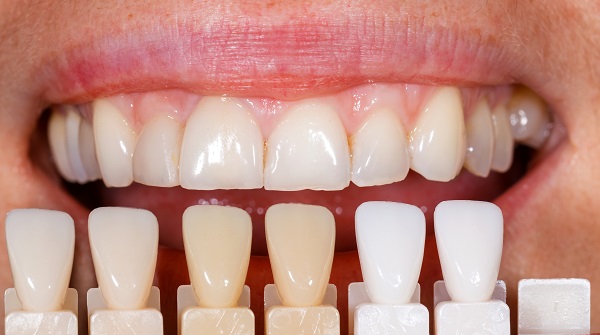
With greater technology and greater access to dental services, more and more patients are turning to their dentists for aesthetic dental procedures, such as teeth shading and whitening. Patients also have heightened their expectations of their dentists because of improved dental technology for these aesthetic procedures.
It can be easy to confuse teeth whitening with shading. While both are a means to achieve a brighter smile, their procedures and results are different. Teeth whitening involves bleaching the patient’s teeth white. Shading, on the other hand, often involve patients who have recently gotten a crown or implant and want it to match the rest of their teeth.
Selecting the right color shade is important. After all, the patient expects a perfect match. Patients can quickly identify the mismatch even if the shade is off slightly. Even if the shade is correct, the shape and texture of the colored tooth can become noticeable. There are many tools and technology available to help dentists pick the best shade and texture possible. Despite these tools, however, mistakes still happen. These mistakes can result in costing both the patient and dentist valuable time and money.
Traditional Ways of Tooth Shade Selection
Believe it or not, the most common way tooth shades are selected is with the naked eye. This simple way of tooth shade selection was the only way the procedure could be done before technology advancements. Many dentists still rely on this method, though it is far from perfect. There are many limitations to merely comparing shades with your eyes. Older dentists may have diminishing eyesight, some might have color blindness, the shade may be altered due to the lighting or angle at which the tooth is looked at or fine details such as tooth seriations that may affect the shading may be overlooked.
Common Tooth Color Shading Selection Problems
Some of the problems in selecting the right tooth shade and texture are unavoidable today because the reliance on the human eye. Technology, is also imperfect. What can be seen as a great match may not satisfy the patient. As with teeth whitening, it is the patient who has the final say.
External factors such as lighting, can easily cause the dentist to misread the desired shade. When the patient notices the wrong color, the procedure needs to be re-done, usually at the expense of the dentist. Some of the common causes of selecting the wrong shade include:
- The type and quantity of light source
- The sample, including textures and layers
- The receiver (i.e., eye) or processor
- Retinal fatigue
- Background effects
- Lighting
- Color blindness
- Age of the receiver
Another problem that can happen with shading is the incorrect isolation of the tooth or teeth that are shaded. When a patient gets some, but not all of his or teeth shaded, those teeth can easily stand out from the others if the right color is not selected. A re-do of this procedure is also needed to be done at the dentist’s expense.
Many of these problems can be avoided by taking greater care and planning.
Dental Shading Solutions
For a long time, the method of measurement used to determine tooth shading is a tool with tabs at the end of which have a porcelain tooth. The tabs have a letter and number associated with each shade. The tabs were held to the patient’s teeth and the one closest to the natural tooth color was selected. A dental technician then took the letter and number code of the selected shade to make the crown or implant.
While a dental technician is still used to color the crown or implant to the desired shade, newer and improved methods used by dentists have emerged in selecting the shade. These methods are listed below:
- Chromascope
- Avita-3D
- Photomed cameras
- Cannon Rebel and Nikon cameras
- 5,000 Calvin bright light
Being in a hurry and making the slightest mistake in shade can lead to unhappy patients, and added, unnecessary time and expenses. At Arrowhead Dental, we offer dentists of all experience levels valuable educational and dental products to help make their practices stand out. Contact us for more information and how we can help your dental practice be the best in town.
